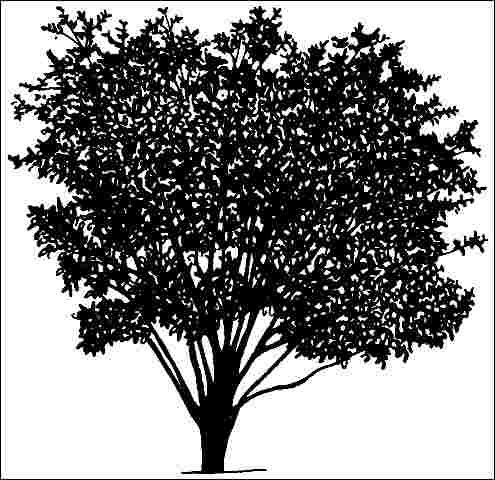Maackia amurensis: Amur Maackia1
Introduction
A very hardy and adaptable tree, Amur Maackia is a slow-growing, deciduous tree which reaches 45 feet tall in the wild but is most often seen at 20 to 30 feet in landscapes. The multi-divided leaflets are grey/green when young but mature to dark green, and often drop in fall without significantly changing color. In summer, dense, erect, 8-inch-long racemes of bloom appear, each small, off-white flower tinged with very pale, dark-blue. These blooms are followed by the appearance of flat, two to three-inch-long pods. Amur Maackia may be well-suited to use as a street or container tree (or in other confined soil spaces in urban areas), where the peeling, orange/brown, shiny bark is especially noticeable. Usually seen with numerous small-diameter trunks originating from the lower trunk. Thirty-five-year-old, single-trunked trees have a diameter of about one foot.

General Information
Scientific name: Maackia amurensis
Pronunciation: MACK-ee-uh am-moor-EN-sis
Common name(s): Amur Maackia
Family: Leguminosae
USDA hardiness zones: 3A through 7B (Fig. 2)
Origin: not native to North America
Invasive potential: little invasive potential
Uses: container or planter; deck or patio; specimen; street without sidewalk; tree lawn 3-4 feet wide; tree lawn 4-6 feet wide; tree lawn > 6 ft wide; highway median; parking lot island < 100 sq ft; parking lot island 100-200 sq ft; parking lot island > 200 sq ft; shade
Availability: somewhat available, may have to go out of the region to find the tree

Description
Height: 20 to 35 feet
Spread: 15 to 25 feet
Crown uniformity: symmetrical
Crown shape: vase, round
Crown density: moderate
Growth rate: slow
Texture: medium
Foliage
Leaf arrangement: alternate (Fig. 3)
Leaf type: odd-pinnately compound
Leaf margin: entire
Leaf shape: oblong, ovate
Leaf venation: pinnate
Leaf type and persistence: deciduous
Leaf blade length: less than 2 inches, 2 to 4 inches
Leaf color: green
Fall color: no color change
Fall characteristic: not showy

Flower
Flower color: white/cream/gray
Flower characteristics: showy
Fruit
Fruit shape: pod or pod-like
Fruit length: 1 to 3 inches
Fruit covering: dry or hard
Fruit color: brown
Fruit characteristics: does not attract wildlife; not showy; fruit/leaves not a litter problem
Trunk and Branches
Trunk/bark/branches: branches don't droop; showy; typically multi-trunked; thorns
Pruning requirement: needed for strong structure
Breakage: resistant
Current year twig color: brown
Current year twig thickness: thin, medium
Wood specific gravity: unknown
Culture
Light requirement: full sun
Soil tolerances: sand; loam; clay; slightly alkaline; acidic; well-drained
Drought tolerance: high
Aerosol salt tolerance: unknown
Other
Roots: not a problem
Winter interest: yes
Outstanding tree: yes
Ozone sensitivity: unknown
Verticillium wilt susceptibility: unknown
Pest resistance: free of serious pests and diseases
Use and Management
Lower branches slowly droop toward the horizontal as the tree grows forming an attractive outline - almost the perfect small tree form. If grown near a walk or along the street be sure to prune early in the life of the tree to locate the lower branches far enough up on the trunk where the drooping branches will not interfere with traffic below. This will eliminate the need to prune older trees which reportedly close over the pruning wound very slowly. Most branches grow upright and will form a wonderful canopy over a sidewalk or narrow road.
Amur Maackia should be grown in full sun on well-drained soil, either acid or slightly alkaline. Plants should receive not be exposed to excessive flooding. Amur Maackia has nitrogen fixing bacteria associated with the root system and should require little maintenance other than some pruning early in the life of the tree. It should be grown and planted more often. It was one of the most drought tolerant trees during the 1988 drought.
Propagation is by seed or by cuttings.
Pests and Diseases
No pests or diseases are of major concern.


